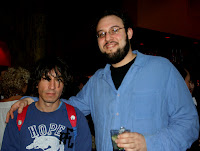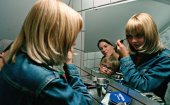 Two boys, Lucas and Nacho, and their sidekick, Andrea, are growing up in a small, remote town in Patagonia. Lucas contends with his parents’ imminent divorce. Nacho obsesses over music and sex, while Andrea is preoccupied with her too-slowly developing body.
Two boys, Lucas and Nacho, and their sidekick, Andrea, are growing up in a small, remote town in Patagonia. Lucas contends with his parents’ imminent divorce. Nacho obsesses over music and sex, while Andrea is preoccupied with her too-slowly developing body. "Glue" is Alexis Dos Santos' gorgeous paean to memory and adolescence. With its soundtrack by the Violent Femmes and engaging performances, "Glue" is a dreamscape of the negative space of memory and desire, rendered in video by a director whose every shot bespeaks a painterly sense of proportion and rupture.
-Interview by Jon Robbins
Where are you living these days?
I was in
What brought you to make a film about adolescents?
Well, I wanted to make a film about teenagers in the way that I experienced that age. A film very close to that emotion and confusions and boiling hormones and thinking about your body changing every day. I like teenage films usually, but I’ve never seen one that expressed what it was like for me at that age. So I tried to transport myself back, and then to write something that would be truthful. And that’s how it all started, that and a few Violent Femmes songs, which I think really express that age. Their first album, that is. Because they recorded the album when they were that age, it comes from that emotional place. They really captured it.
Funny, I was listening to Blister in the Sun the other day. Such good music and so powerful. As a soundtrack, that album would overwhelm most films, but for “Glue” it fit right in.
It was so easy, it was included in the story somehow. And I only use music that the characters listen to, no extra-diagetic stuff, except for one place at the very end. And the energy is just the right energy for the film.
When the music is so out of control, with that careening bass, your movie is so poised…
Yeah, but what’s going on inside the characters is not so poised. It’s like the bass, as you say. And there’s so much going on inside them, but it’s not expressed, just building up inside them, vibrating. Watching “Glue,” I thought it really captured the formative nature of adolescence, and in this sense I found it to be a very filmic film.
Watching “Glue,” I thought it really captured the formative nature of adolescence, and in this sense I found it to be a very filmic film.
Yeah, you can see all that in the Super 8, even hair on the film, the dirt of the place.
Which gave it such incredible texture. The negative space often defined the positive space, giving it this sense of absence as presence.
Yes, it’s like this idea of the past that is always present. As soon I say something, it belongs to the past, however ‘present’ it may be. In the film it’s not so articulated as that, but yes, it is a sort of memory-texture, a record of thought process. Especially with the Super 8 with the voice-over, when the kids are going back, I wanted to have a filmic way of portraying the subjective experience of remembering.
Why two boys and two girls? Any reason?
That’s how the story started.
One scene I really like is when the girl has the boys up to her bedroom. She asks what they want to drink, and they say chocolate milk. I thought she might have wanted to serve them liquor...
Oh! I don’t think so. In
So no liquor?
No.
Did you study art history or painting?
I studied architecture for five years.
For "Glue," I had a very good DP, Natasha Braier. We tried to devise a palate that would express the characters’ emotions. This comes through a combination of takes and choices and the feeling that Natasha and I have for colors and textures. We were in tune, reading the same books, seeing the same movies. We have an excellent working relationship. How long did “Glue”take to shoot?
How long did “Glue”take to shoot?
Three and a half weeks. And the process of making this film was very particular.
Everything was very alive in the moment in front of the camera. It was all based on improvisation. I only had a ten-page script. Well, I had a story, and the structure of the film was there, but everything was a few lines or a paragraph as opposed to the three, four, five pages of a script. A lot of the camerawork and the editing came from this process, how free we were at the time of making it. Instead of establishing set scenes, we would just follow the actors as if it were a documentary. And like in a documentary you don’t know what’s coming next. And we were never sure what was going to happen in front of the camera.
This was the case with all the kids’ voiceovers. I had asked the kids to record their own thoughts just to help them work out their characters: 'what do you thnk of your family, your friends, life and death, what do you want in life?' And then I found these three kids had recorded this amazing stuff. Especially the stuff from the girl, it was just heartbreaking and really beautiful. I would like to do an art installation with voiceovers and the Super 8: there’s so much there. So, yeah, the process of how the film was made was organic.
We shot it in video. This was the best way to use digital. I found you could make more out of it this way than to try to make it look like film. That you can record forever and it doesn’t cost any money alleviates a lot of pressure. There is a smaller crew, less lighting. If there is something special about this film, it comes from the way it was made.
-Interview by Jon Robbins


No comments:
Post a Comment